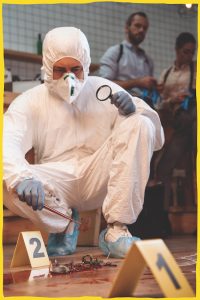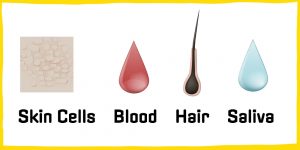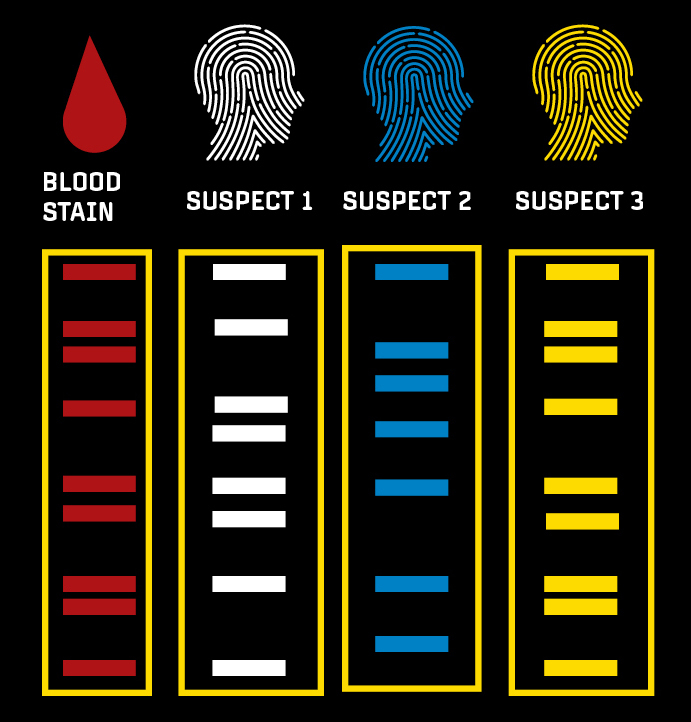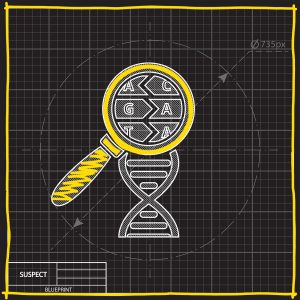An Everyday DNA blog article
Written by: Sarah Sharman, PhD, Science writer
Illustrated by: Cathleen Shaw

The true crime genre really boomed over the past few years. Hundreds of true crime podcasts and documentaries are available in our streaming feeds. And I will admit, as a 30 something year-old who grew up watching shows like CSI and Criminal Minds, I got caught up in the true crime wave.
Every week I listen to My Favorite Murder and The Murder Squad podcasts. I binged the documentary shows The Jinx and Making a Murderer. I even followed the breaking of the Golden State Killer case with bated breath. For me, though, I am most intrigued by the science behind the true crime curtain.
Forensic science, or the use of scientific methods to investigate crimes, has helped solve cases in the criminal justice system for centuries. Advances in DNA sequencing technology over the past few decades, however, has led to a surge in both convictions and exonerations for many crimes. Let’s learn about how DNA and genetics play a role in solving cases.
DNA fingerprinting
There is DNA in nearly all of the cells of our body. It is made up of four nucleotide bases, represented by the letters A, T, C and G. Our cells use the DNA code to make the proteins and molecules necessary for all of the functions of our body. Because we each have a unique DNA code, it can also be used to identify individuals.
 Forensic science increasingly relies on small bits of DNA left at crime scenes to link criminals to the crimes they commit. DNA can also be used to define paternity, exonerate the wrongly accused, and identify victims of crime, disasters, and war. Skin cells, blood, hair follicles, and saliva all contain DNA that can be used to identify an individual.
Forensic science increasingly relies on small bits of DNA left at crime scenes to link criminals to the crimes they commit. DNA can also be used to define paternity, exonerate the wrongly accused, and identify victims of crime, disasters, and war. Skin cells, blood, hair follicles, and saliva all contain DNA that can be used to identify an individual.
If you’re a true crime fan like me, you have probably seen your fair share of investigations on popular television shows. Finding a perpetrator and bringing them to justice using DNA is often portrayed as a simple, exact, and infallible method. However, determining the likelihood of a DNA match between a suspect and a crime scene is a complicated process.
Although 99.9% of genomes are identical across all humans, there are regions of variation that are unique to each individual. A technique called DNA fingerprinting takes advantage of some of these differences to identify individuals based upon their DNA. Originating in the mid-1980s, DNA fingerprinting is now commonly used as a law enforcement tool.
DNA fingerprinting looks at differences in sections of DNA called short tandem repeats (STR). STRs consist of a string of repeating DNA nucleotides that are usually two to five bases long (like CAGCAGCAG or AATGAATGAATG for example). There are many STRs throughout the genome, each having different repeating units with different numbers of repeats.
Everyone has the same STR at the same place in the genome but the number of repeats varies between individuals. For example, I might have a CAG unit that is repeated five times while you have CAG repeating eight times. The differences in the number of repeats means that people have STRs of different lengths which can easily be measured using a few lab techniques.
 To create a DNA fingerprint, DNA must first be extracted from a sample collected from a crime scene, a suspect, or an individual in a paternity case for example. The region containing each STR being analyzed is then copied many times using a technique called polymerase chain reaction. Afterwards, the STRs are separated according to their size. In the United States, law enforcement agencies and the Federal Bureau of Investigation (FBI) analyze 20 STRs when creating DNA fingerprints.
To create a DNA fingerprint, DNA must first be extracted from a sample collected from a crime scene, a suspect, or an individual in a paternity case for example. The region containing each STR being analyzed is then copied many times using a technique called polymerase chain reaction. Afterwards, the STRs are separated according to their size. In the United States, law enforcement agencies and the Federal Bureau of Investigation (FBI) analyze 20 STRs when creating DNA fingerprints.
The profile from the sample from the crime scene is compared to the sample from the suspect (similar to the image to the right). If the STR profiles from the two samples do not match, the individual would be excluded as the source of the crime scene evidence (Suspects 1 and 2). But if the two samples match across all 20 STRs (Suspect 3), a statistical calculation would be made to determine the frequency at which the full set of STRs is observed in the population. The likelihood of any two individuals having identical STR profiles is less than one in a quintillion (1,000,000,000,000,000,000).
DNA profiles can be entered into a database called Combined DNA Index System (CODIS) so that federal, state, and local agencies can exchange and compare DNA profiles electronically. When a suspect’s identity is unknown, law enforcement can enter the crime scene DNA profile into CODIS to see if it matches any other profiles that have been uploaded. Comparing a profile to others in CODIS can link crimes together and link suspects to a crime scene.
Forensic genealogy
DNA fingerprinting does not always turn up a viable lead. For cases that cannot be solved using DNA fingerprinting, there are new and emerging technologies to help solve crimes. One emerging technique, called forensic genealogy, combines DNA analysis with traditional genealogy research to generate investigative leads in crimes. The most widely publicized case that has been solved using forensic genealogy is the Golden State Killer case.
 Instead of looking at STRs like DNA fingerprinting, forensic genealogy examines more than half a million single nucleotide changes to DNA (called single nucleotide polymorphism, or SNP). Using the SNPs, scientists can identify sections of DNA that are shared between samples, like a crime scene sample and an individual.
Instead of looking at STRs like DNA fingerprinting, forensic genealogy examines more than half a million single nucleotide changes to DNA (called single nucleotide polymorphism, or SNP). Using the SNPs, scientists can identify sections of DNA that are shared between samples, like a crime scene sample and an individual.
The SNP profile that is created from a crime scene sample can be entered into a public DNA database (like GedMatch). The SNP profile is compared against the genetic profiles of individuals who voluntarily entered their DNA profile into the databases. Using the profiles, genetic genealogists piece together family trees in hopes of identifying individuals from their distant genetic relatives.
Once a potential suspect has been identified, law enforcement must fully investigate each suspect. If they think a suspect is a good match based on the rest of the information in the case, law enforcement must lawfully obtain a DNA sample from the suspect to compare to the crime scene DNA. Only if there is an exact DNA match can an arrest be made.
DNA is giving does their names back
HudsonAlpha Discovery™, a genetic sequencing lab located on the HudsonAlpha Institute for Biotechnology campus in Huntsville, Alabama, is doing their part to help John and Jane Does regain their identities. The company supports the work of the nonprofit organization DNA Doe Project in identifying unidentified victims from cold cases.
The DNA Doe Project uses forensic genealogy to identify John and Jane Does. On April 10, 2018, just two weeks before the Golden State Killer was arrested using the same technology, the DNA Doe Project announced that it had used genetic genealogy to identify a Jane Doe, previously known as the “Buckskin Girl”. Since that first case, the DNA Doe Project has helped identify more than 40 victims in cold cases using forensic genealogy.
HudsonAlpha Discovery plays a key role in these forensic genealogy cases- performing whole genome sequencing on the samples of DNA. They have worked on more than 1,100 forensic cases with the DNA Doe Project and other agencies. The most recent case for which HudsonAlpha Discovery provided sequencing services was the identification of a previously unidentified victim of the sexual predator and serial killer John Wayne Gacy.
DNA is a powerful tool for forensic science and companies like HudsonAlpha Discovery and the DNA Doe Project are helping to make it accessible for more victims and their families.


